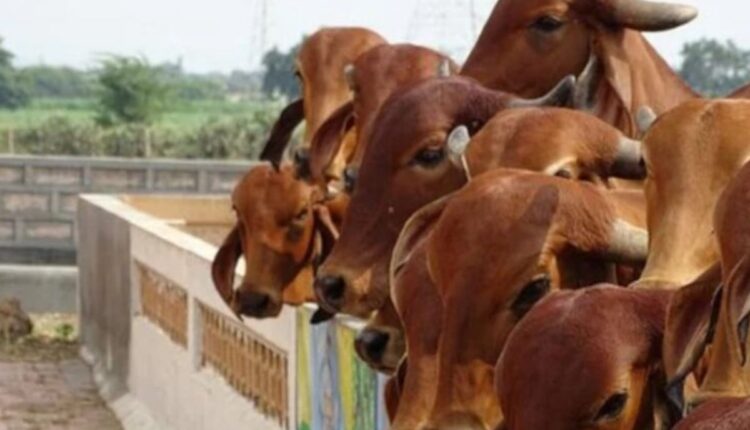Livestock Management System: Farmers should adopt smart strategy of livestock management, know management tips
Livestock Management System: Livestock is a business of billions of dollars in today’s time. Livestock management, including India, accounts for a large part of GDP (Gross Domestic Product). The food supply of people is based on livestock products. Which includes meat, dairy products, are used by people. To manage livestock products (Livestock Management System), farmers are often unable to do livestock management, due to which they may have to suffer losses.
Livestock is a business of billions of dollars in today’s time. India accounts for a large part of GDP (Gross Domestic Product) in livestock management in the whole world. The food supply of people is based on livestock products. Which includes meat, dairy products, are used by people. To manage livestock products (Livestock Management System), farmers are often unable to do livestock management, due to which they may have to suffer losses.
Livestock Management System is a systematic way
Livestock Management System is a way to properly organize livestock and animal husbandry. Under this, livestock management can be made better as well as technological. Good management in livestock management system helps in the management of dairy animals and livestock.
Livestock management system helps farmers. It reveals the right ways to maintain their proper nutrition, hygiene, living arrangements along with veterinary examination.
Use of livestock management system
Farming and agriculture is a huge industry in India. Every animal like cattle, buffalo, pig, goat, cow that can be raised in the field is considered a livestock animal. An understanding of the proper use and care of ‘livestock’ is developed under the livestock management system.
There is no doubt that animal owners need additional time, resources and capital investment to manage livestock. Keeping these challenges in mind, the use of livestock management software is becoming very popular among smart farmers. The livestock management system market is estimated to be US$3 billion. For traditional farmers, livestock farming is an important source of their second income. Most livestock farmers manage their livestock using traditional methods, where problems are often not solved scientifically.
Improper livestock management increases the risk of diseases in animals, as they are exposed to sick animals. Farmers should ensure that they implement the livestock management system smoothly.
Regular veterinary checkups of livestock
Regular veterinary checkups are essential to maintain the health of livestock. Farmers should partner with a qualified veterinarian who can conduct regular checkups, vaccinations and treatments. Early identification and treatment of diseases can significantly reduce mortality and increase the overall productivity of livestock.
Provision of complete nutrition of livestock
Providing complete nutrition to livestock is also very important for their growth and production. Indian farmers should focus on a balanced diet that meets the specific nutritional requirements of each type of livestock. This includes a mixture of roughage, minerals and vitamins. Proper feeding practices should also be followed.
Temperature change and livestock management system
Climate change also affects livestock greatly. Temperature change has seriously affected livestock. Therefore, livestock management system is important, because due to untimely change in weather, the health and fertility of animals is greatly affected. Due to which the quality of animal products also decreases.
Untimely change in weather is reducing the fertility of dairy animals. As a result, the pregnancy rate is also decreasing significantly. The risk of mastitis, inflammation of the uterus and other types of diseases increases.
Hygiene and cleanliness in livestock housing
Proper cleanliness in livestock housing and feeding area is very important to prevent the spread of diseases. Regular cleaning of barns, sheds and equipment used can protect livestock from diseases to a great extent.
At the same time, disinfection reduces the risk of infection. The place where your livestock is housed should have adequate ventilation, and a waste management system should be used.
Preparing housing for livestock
It is very important to build housing for animals. Having housing protects your livestock from heat, cold and rain. The most important thing for housing is that while building it, full focus should be on the comfort and health of the animals. The cattle shed should be airy and have good lighting.
If you are building a house for animals near the farm, then build it near or under a shady tree, so that they can avoid both cold and hot winds. While building a cattle shed, make sure that the floor is not made of cement and concrete, because it can cause injury or even death to the animals.
Pay attention to these things in the livestock management system
The first thing in livestock management system is to provide sufficient and appropriate amount of food to the animals. The food of the animals should be a balanced diet.
There should be adequate availability of clean drinking water for the animals.
Make sure your livestock sits in the sun, this is very important for their health.
Keep consulting the veterinarian from time to time.
Make sure to arrange proper housing for your animals.
Set a time for milking animals.
Useful tips for livestock management system
1. Ensure balanced diet
Proper nutrition is important for the health and productivity of animals. Keep the right balance of energy, protein, minerals and vitamins in the diet.
2. Maintain cleanliness
The living place of animals should be clean and germ-free. This reduces the chances of diseases.
3. Pay attention to water management
Provide clean and fresh water to the animals in sufficient quantity. Lack of water can affect their productivity and health.
4. Breeding Management
Select healthy males and females for high quality breeding. Monitor breeding cycles and use modern techniques like timely artificial insemination.
5. Reduce stress
Provide a comfortable and safe environment to animals to keep them stress free. Avoid loud noises or unnecessary crowding around them.
6. Pay attention to disease symptoms
Keep an eye on the movements, appetite and behaviour of sick animals to identify them. Early treatment can prevent major problems.
7. Select the right breed
Select breeds that are suitable to the climate and environment of your area, which are low-risk while giving high production.
8. Use of technical tools
Use GPS tracking, RFID tags and other modern tools for livestock management so that monitoring and recording of animals is easy.
9. Adopt biosecurity measures
Take care of the hygiene of people and vehicles coming from outside to prevent external infections in the livestock farm.
10. Fodder management
Provide quality green and dry fodder in sufficient quantity. Preserve fodder using crop residues and silos.
11. Proper waste management
Reuse animal waste as manure. This will protect the environment and increase soil fertility.
12. Care according to climate
Provide shade and cold water to animals in summer. Use blankets or other measures to keep them warm and dry in winter.
13. Get animal insurance
To avoid any unexpected loss of animals, take an insurance policy.
Livestock management software
Software is being used today for livestock management system. With the help of these softwares, tracking cattle in real time, farm mapping, grazing analysis connects. It makes farm operations easier.
Contact us – If farmers want to share any valuable information or experiences related to farming, they can connect with us via phone or whatsapp at 9599273766 or you can write to us at “[email protected]”. Through Kisan of India, we will convey your message to the people, because we believe that if the farmers are advanced then the country is happy.
You can connect with Kisan of India on Facebook, Twitter, and Whatsapp and Subscribe to our YouTube channel.



